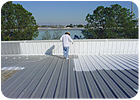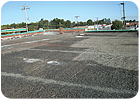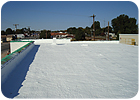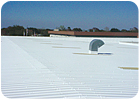
Photo
courtesy of Aldo Products Company.
Roof replacement is an expensive proposition for building owners and facility professionals. Material costs have escalated in the past year for material manufacturers, making replacement costs as expensive as ever. The result is professionals in charge of roofing are more proactive in seeking the most cost-effective means of meeting their roofing needs.
If the roof system is leaking or approaching the end of its service life, a building owner or facility manager has more options today to explore than ever before. One of the great advantages of the Internet age in which we live is that the research for the solution can begin without that building professional ever leaving his office. However, many times this research can raise as many questions as it answers. There is a wide range of roofing systems and restoration products available, and not all are appropriate for every situation.

Figure
1: This shot of the existing BUR and aggregate over an 80-year-old office
building and manufacturing facility shows the state of the roof before it was
replaced.
In addition to answering these questions, most building professionals will want to defer the cost of complete roof replacement if possible. This is only an option if the existing roof system has service life remaining. A thorough inspection by an industry professional can accurately make this assessment.

Figure
2: This photo shows the roof after spray polyurethane foam was applied and
covered with a bright white acrylic coating to protect the SPF from ultraviolet
degradation.
SPF Case Study
Consider the project illustrated in the before-and-after photos labeled Figures 1 and 2. The building had an older gravel built-up roof (BUR) over an office and manufacturing facility. The owner could not afford the downtime involved in a tear-off and roof replacement project. He was also seeking a way to increase the insulation capability of this almost 80-year-old building. The choice of a spray polyurethane foam roof covered with a bright white acrylic coating was an ideal solution.After a thermal scan was performed to determine no extensive trapped moisture existed in the current roof system, the decision to proceed was made. As part of the prep process, all of the older aggregate was removed. The owner made use of the gravel to shore up his gravel parking area so the product removed from the roof never left the property. The older wood deck, still in good shape, was relieved of the weight of the aggregate as well.
Once the gravel was removed, the surface was primed completely to ensure maximum adhesion of the spray polyurethane foam to the substrate. Most primers available today will set up quickly to allow the SPF to be applied the same day on any primed section. A minimum of 1.5 inches of a 2.8 pounds per square foot roofing foam was installed over the field of the roof. Given the adequate positive slope of the roof, an acrylic coating proved to be the appropriate choice to protect the SPF from ultraviolet degradation. A base coat of gray preceded the bright white top coat. This entire project was completed with no roof tear-off or aggregate being hauled away to the area landfill and no interruption to the manufacturing process inside the facility. The newly installed finished system has eliminated all of the leaks and reduced the load on the roof. It is also lowering energy costs. And this new roof can be sustained through recoating at the 10-year anniversary of the original SPF installation. This owner is also conducting an ongoing energy audit to determine their actual payback period for this new roof investment.

Figure
3. This 100,000-square-foot commercial warehouse building had several leaks in
its metal roof. After the metal roof was thoroughly cleaned and all
penetrations were sealed, a two-coat application of an acrylic elastomeric
restored the roof to a leak-free state and lowered the surface temperature.
Solutions For Metal Roofs
Metal roofs are also excellent candidates for a reflective coating system. The project featured in Figure 3 was a 100,000-square-foot commercial warehouse building with multiple tenants. Once the roof leaks became widespread, the owner was forced into coming up with a solution quickly or risk losing monthly rental revenue.The decision to have an elastomeric, reflective coating installed proved to be the correct one for this owner. The roof was effectively prepared by thorough cleaning and sealing all penetrations, skylights and fasteners with an acrylic seam sealer. Only limited areas of rust were present, and therefore only spot priming was necessary. A two-coat application of an acrylic elastomeric not only restored the roof to a leak-free state, it also resulted in lowering the surface temperature as well. The tenants noticed a more comfortable environment in the non-climate controlled warehouse areas, as well as lower utility bills in the air conditioned office areas. Furthermore, the new white roof surface will greatly reduce the thermal shock (expansion and contraction of the metal during temperature changes) that occurred to the uncoated metal roof, ultimately extending the service life of the roof.
These two projects underscore the advantages of using reflective roof coatings in suitable applications. The roof coating industry today features state of art chemistry in product formulation and decades of field application experience. This combination has resulted in another revenue stream for roofing contractors while providing quality solutions that meet the needs of their clients. And, while the overall commercial roofing industry may see some challenges during the coming year, look for opportunities with reflective roof coatings to continue their growth.